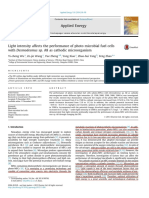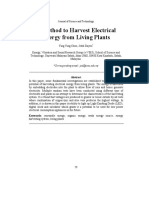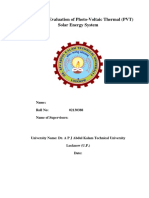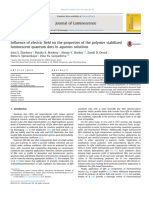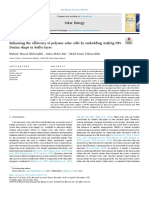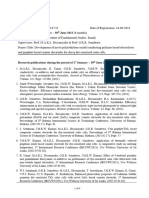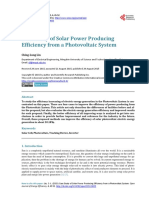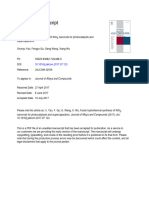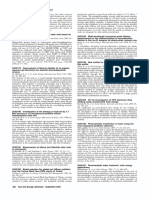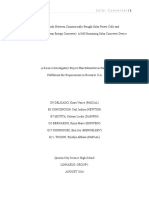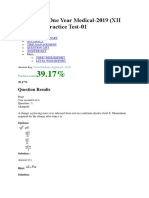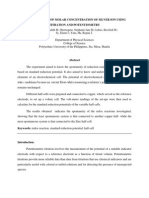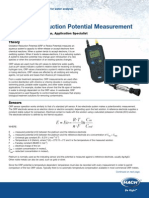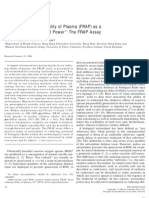Professional Documents
Culture Documents
Electrical Output in Photogalvanic Cell For Conversion of Energy and Storage by Using Bismarck Brown With Different Reductant
Original Title
Copyright
Available Formats
Share this document
Did you find this document useful?
Is this content inappropriate?
Report this DocumentCopyright:
Available Formats
Electrical Output in Photogalvanic Cell For Conversion of Energy and Storage by Using Bismarck Brown With Different Reductant
Copyright:
Available Formats
Volume 8, Issue 1, January – 2023 International Journal of Innovative Science and Research Technology
ISSN No:-2456-2165
Electrical Output in Photogalvanic Cell for
Conversion of Energy and Storage by Using
Bismarck Brown with Different Reductant
Sushil Kumar Yadav1, Sangeeta Sharma2 and Abhilasha Sonel3
1,2,3
Solar Photochemistry Research Lab,
P.G. Department of Chemistry,
Govt. Dungar College (Three times ‘A’ Grade),
M. G. S. University Bikaner 334001, India
Abstract:- Photogalvanic (PG) cell are dye-sensitized photoelectrochemical effect, and it is known as the Becquerel
solution-based solar energy converters and storage effect, which is the origin of the photovoltaic wonder. Fox,
devices. The photogalvanic of Bismarck Brown (BB) as a Kabir-Ud-Din and Singletary [1979] observed five photo
dye sensitizer with different reductant such as Ascorbic processes entail basic carbanion, which are ring opening,
Acid (AA), EDTA, and Glucose (Glu.) have been isomerization anionradical creation, reductive alkylation, and
investigated in order to obtain new insights into how to electron transfer with anodic current production, indicating
make PG cells that become relatively cheaper, cleaner, that carnation undergoes photoinduced chemical reactions.
and environmentally acceptable. In this study, three
systems BB - AA, BB - EDTA, and BB – Glu were Aliwi, Naman and Al-Dhstani [1986] reported that in a
examined utilizing PG cells. The Photocurrent generated photogalvanic cell with platinum electrode, photogalvanic
by these systems was 915 mV, 810 mV and 720 mV and effect in a photo redox couple constituted of
Photopotential generated by three systems was 155 μA, Vanadium(III)bis(2,2'-bipyridyl)Chloride and Fe(III) was
135 μA and 120 μA, respectively. The factor of fill for BB investigated in aqueous solution. They found that incident
- AA, BB - EDTA, and BB - Glu systems were 0.54 %, 0.48 light intensity has a direct relationship with cell photocurrent
% and 0.40 %, Efficiencies of conversion for BB - AA BB and photopotential, and that photo current and photopotential
- EDTA, and BB - Glu systems were 0.899 %, 0.614 % and are proportional to incident light intensity. Baranham, Mazzer
0.405 % and Capacities of storage for BB - AA, BB - and Clive [2006] observed the It will take fresh initiatives to
EDTA, and BB - Glu systems were 40 min., 34 min. and increase the efficiency with which incoming photons are
31 min., respectively. The effects of various factors on the harvested by using Safranine-o used as a photosensitizer. The
electrical outputs of the cell have been observed, and a photopotential and photocurrent generated were respectively
mechanism for the generation of photocurrent in PG cells 790.0 mV and 185.0 A. The observed conversion efficiency
has also been suggested. was 0.1469 percent, the fill factor was 0.08, and the cell's
highest power was 146.15 W, whereas the photogalvanic
Keywords:- Bismarck Brown, Glucose, EDTA, Ascorbic cell's power at power point was 15.28 W.
Acid, Conversion Efficiencies, Fill Factor.
Yadav, Singh and Yadav [2009,2010] were investigated
I. INTRODUCTION the photogalvanic effect of photosensitizer – reductant by
using the Victoria Blue and Ascorbic Acid system and
The development of technology for producing Thionine- EDTA- CTAB for solar energy conversion and
renewable energy is in high demand in today's globe. We are storage. This cell produced a photopotential of 662mV and a
up against a challenge to supply the growing global demand photocurrent of 150A, respectively. The cell's maximum
for electricity without harming the environment. The amount power output was 53.5 watts. The conversion efficiency was
of sun light that touches the world in an hour is greater than found to be 0.5144 percent, with a fill factor of 0.50.
the total power that the earth expends in a year. The greatest Gangotri, Regar , Lal , Genwa , Kalla and Meena
tool for converting solar power into electrical power is a solar [1997,2011] studied a comparison of photogalvanic cell
focused cell. The goal of research on sunshine-based cells is performance with several photosensitizers for solar energy
to improve the efficiency of sunlight conversion while also conversion and storage of D-Xylose-NaLS systems using
addressing the need for a viable power source. several photosensitizers such as Methyl Orange, Rose
Bengal, Toluidine Blue, and Brilliant Cresyl Blue, as well as
Becquerel [1839] found that a power and electric current D-Xylose as a reductant and Sodium Lauryl Sulphate (NaLS)
was formed when a silver chloride cathode was immersed in as a surfactant.
an electrolyte and connected to a counter terminal that was lit
up with sunshine. It was the beginning of the forefront period
of photoelectrochemical cells in terms of
IJISRT23JAN142 www.ijisrt.com 254
Volume 8, Issue 1, January – 2023 International Journal of Innovative Science and Research Technology
ISSN No:-2456-2165
Yadav [2017] reported the Comparative Study of solutions were stored in amber-colored bottles to keep them
photogalvanic effect by using of Rose flower Extract as out of the sun. As a photogalvanic cell, an H-shaped cell was
photosensitizer with Mannitol and NTA as reductant for solar utilised with a known number of photosensitizers, sodium
energy conversion and storage performance. Yadav [2018] hydroxide, reductant, distilled water and the total volume was
explained that in this study, the photogalvanic effect was adjusted to 25 ml. The H type cell's one arm was submerged
investigated. The natural dye was Rose Extract, while the in a saturated calomel electrode while the other arm was
reductant was Nitrilotriacetic acid. The voltage and current immersed in a platinum electrode. Alkali solution was
generated by this cell were 872 mV and 176 A, respectively. employed to keep the pH of the fluid in the photogalvanic cell
The conversion efficiency was 0.79 percent and the observed stable when needed. Standard oxalic acid used to standardise
power at power point was 82.18 W. At the cell's power point, the alkali solution, and a digital pH metre (Systronics model
the fill factor 0.4678 was determined experimentally. The PG 802) was utilised to measure the pH though solution. At a
cell can be used in dark for 42 min. and charging time was predetermined time period, an electronic pH metre was
200 min. utilised to monitor the system's fluctuation in potential
difference. To achieve a steady potential, the device was first
Chadra M, Shree T [2019] Reported renewables have maintained in the dark. This stable potential became the dark
the potential to play a significant role in rural electrification potential when the platinum electrode was lit via the window
if we properly equip and utilise these technologies and generated in the H type cell's arm. A 200W tungsten filament
opportunities. Energy conservation is one of the most lamp was used as a light source. After illuminating the system
important issues. As a result, new technology and energy for a length of time, a steady potential is obtained. The
efficiency are critical to solving our energy conservation and photopotential is calculated by subtracting the dark potential
global warming challenges Photogalvanic effect has observed from the stable potential obtained after lighting (mV). The
in a system which contain a dye Victoria Blue act as current generated in the photochemical system was measured
photosensitizer and a reducing agent Ascorbic acid. using a micro-ammeter (New Tech, India).
Koli, Dayma, Pareek and Jonwal [2020] explained that After achieving a stable photopotential under
Congo red is being used in photogalvanic cells to improve illumination, the current was measured. In the same system,
simultaneous solar energy conversion and storage. Congo red changes in current with respect to time, maximum
dye has been observed to have lower aggregation at high pH, photocurrent, and current at equilibrium were observed. The
which makes it suitable for photogalvanic applications. Koli system's current-voltage (i-V) experiments were conducted
P, Pareek, Dayma and Jonwal [2021] observed that utilising an inside the circuit an external load (log 470K)
Photosensitizer Indigo Carmine dye-surfactant Sodium determine the power point, which is defined as the point at
Lauryl Sulphate-reductant Formic acid–NaOH alkaline which the multiplication of potential and current is greatest.
medium photogalvanic cells have shown encouraging and The cell's performance was measured at its maximum power.
very impressive improvements in solar energy conversion It was calculated using the pace at which the cell's power
and storage. dropped when the illumination was turned off. To achieve
current and potential values that were equal to those at power
Chandra [2021] Studied on four systems namely Rh B point, an external load was used. The time it took to reach half
– EDTA - Tween80, MB – DTA -NaLS, Rh 6G – EDTA - of the power point value was then recorded. This is referred
CTAB & Safranine - EDTA – ALS in PG cells and In the year to as t1/2, and it is a measure of a cell's ability to function in
2050, it was also reported that in developing regions of the the dark. The Factor of Filling of the cell was determined
world, energy consumption is expected to expand fast, with using the formulae where ipp and Vpp denote photocurrent and
the fundamental energy requirement not being met photopotential at power point, respectively, and Voc and isc
satisfactorily. Koli [2021] observed the Sudan-I dye denote open and short circuit photopotential and
(photosensitizer)-Fructose (reductant)-Sodium Lauryl photocurrent, respectively. Conversion Efficiency in Cells
Sulfate (surfactant) photogalvanics have been studied in was determined using current and potential values at the
alkaline medium at low and artificial sun intensity with the power point, as well as light intensity. The formula was as
goal of finding a relatively better combination of follows:
chemicals like photosensitizer, reductant, and surfactant
for further enhancing the efficiency of these cells. V pp i pp
Conversion Efficiency = 100 % ,
II. MATERIALS AND METHODS 10.4mWcm 2
Bismarck Brown, which was utilized as a photo- Photopotential and photocurrent at point of power are
sensitizer, is a metachromatic dye with the chemical formula denoted by Vpp and ipp.
(H2N)2C6H3N2]2C6H4 with a molecular mass is 419.31.
Three Reductant was used (1) Ascorbic Acid has the chemical
formula C6H8O6with a molecular mass is 176.12, (2) EDTA
has the chemical formula C10H16N2O8 with a molecular mass
is 292.2438 and (3) Glucose has the chemical formula
C₆H₁₂O₆ with a molecular mass is 180.156. Triple distilled
water was used for the preparation of these solutions. These
IJISRT23JAN142 www.ijisrt.com 255
Volume 8, Issue 1, January – 2023 International Journal of Innovative Science and Research Technology
ISSN No:-2456-2165
III. DISCUSSIONS AND FINDINGS and 13.4, A min-1 in BB-Glu. System, respectively. In the
BB-AA System, the short circuit current (isc) (ieq) was
A. Potential Variation during Time measured at 155.0 A, 135.0 A in the BB-EDTA System, and
After the photogalvanic cell has been put in the dark, the 120.0 A in the BB-Glu. System. The outcomes are shown in
electrode of platinum was affected by light until it attained a Graph- 2.
steady potential. It had been discovered that when
illumination increased, potential altered and eventually
reached its maximum value after a period of time. When the
light source was removed, the cell's potential was reduced,
and after some time, a steady potential was achieved. After
obtaining a stable potential by keeping the system dark, the
potential increased with lighting and reached its maximum
value, known as open circuit voltage (Voc), before the light
source was removed and the cell's potential was lowered.
Graph- 1 shows across all three systems, the fluctuation of
potential with time in pg cell. The potential was found to
increase when the source of light was illuminated; the
direction of possible change was discovered to be reversed
when the source of light was removed. In all three systems,
distinct time periods were noted for obtaining the stable dark Graph 2. Displays how current changes over time.
potential as well as achieving a stable potential after lighting.
In the following the photogalvanic cell is most efficient
with the BB-AA System and least efficient with the BB-Glu.
System, according to the overall results.
C. Variation in pH's Effect
The impact of a pH shift on photopotential in the three
systems is presented in Graph- 3. All three systems with
photosensitizers (dye) were found to work efficiently in the
strong alkaline range. pH=12.7 to 13.0 was the working range
for this study. The photopotential of the system was observed
to grow as the pH was raised, reaching a maximum value for
a certain pH, and then falling as the pH was raised further.
Graph1. Indicates how potential changes over time.
The BB-AA System had the highest open circuit
voltage, whereas the BB-Glu. System had the lowest. The
BB-AA System had the highest voltage at power point, while
the BB-Glu. System had the lowest. In the BB-AA System,
BB-EDTA System, BB-Glu. System, the rate of change in
potential on illumination was 6.02, 5.28, and 4.48 mV min-1,
respectively. In the BB-AA System, BB-EDTA System, BB-
Glu. System, the rate of change in potential after removing
the source of light was 2.23, 2.11, and 1.86 min-1,
respectively. Voc and V for BB-AA system =1110.0 mV and Graph 3. Shows the Effect of Variation of pH
915.0 mV, Voc and V for BB-EDTA system =980.0 mV and
810.0 mV and Voc and V for BB-Glu. system=870.0 mV and The needed pH was found to be larger than the
720.0 mV. As a result of the following the photogalvanic cell reductant's pKa values in every example tested in this
is most efficient with the BB-AA System and least efficient investigation (i)Enhanced dye solubility and lowered dye
with the BB-Glu. System, according to the overall results. aggregation at higher pH ranges result in increased dye
diffusion in the liquid electrolyte, (ii) enhanced solubility and
B. Current Variation during Time lowered dye aggregation at higher pH ranges result in
The current in all three systems rapidly increases after a enhanced dye diffusion in the electrolyte solution, and (iii)
few minutes of illumination, reaching maximum value (imax) enhanced solubility and lowered dye aggregation at higher pH
of 198.0, 180.0, and 170.0 A in the BB-AA System, BB- ranges result in higher dye diffusion in the electrolyte
EDTA System, and BB-Glu. System, respectively, and rates solution, and (iv) the fact that dye reduction and full
of the first generation of current are in the order of 19.2, 15.3,
IJISRT23JAN142 www.ijisrt.com 256
Volume 8, Issue 1, January – 2023 International Journal of Innovative Science and Research Technology
ISSN No:-2456-2165
solubilization need a pH range of 12.7–13. At pH greater than power. By favouring reverse electron processes from the
13 (which implies a very high concentration of OH), the drop sensitizer to the reductant, a larger number of reduction agent
in current and power can be ascribed to an obstruction in the molecules may impair cell efficiency.
regeneration of the reductant original state due to a higher
chance of OH ions recombination with the oxidised state of E. Variability's Effect of Photosensitizer (Dye)
the reductant. When concentration of photosensitizer was increased,
the photopotential and photocurrent increased as well. The
The oxidation potential of the reductant molecule and level of photosensitizer (Dye) was controlled between 2.410-
the reduction potential of the photosensitizer molecule 6 and 5.610-6 M for effective results in electrical output.
influence the photo-reduction of the dye molecule in the There will be a limited number of photosensitizer molecules
presence of various reductant in different pH ranges. The to absorb solar light in the cell at the lower end of the
effect of pH on the PG cell's electrical performance may thus photosensitizer concentration range, resulting in low
be explained. The PG cell functions poorly at very low pH. electrical output, whereas higher photosensitizer
At very low pH, the photosensitizer and reductant have weak concentrations will prevent the desired intensity of light from
electron donating power to the Pt electrode due to proton reaching the photosensitizer molecules near the electrodes,
attachment to the heteroatom and double bonds in resulting in the rapid drop in electrical output.. Influence of
photosensitizer and reductant. different Bismarck Brown concentration as a photosensitizer
(Dye) has been shown in Graph- 5.
D. Variability's Effect of Reductant
When the concentration of three reducing agents was
increased, it was discovered that Ascorbic Acid, EDTA, and
Glucose was increased in different systems with Bismarck
Brown as the photosensitizer, the output of these cells
increased, reached In all cases, the maximum value was
reached and then declined when the concentration of
reduction agent was raised further. The dye-to-reductant ratio
was maintained at 1:105-101 in these systems. The lower the
reductant concentration, the lower the electrical output, The
dye molecule travels slowly towards the electrode because
there are less molecules available for electron donation, and
the higher the reduction agent concentration, the fewer
molecules accessible for electron donation. Graph 4 shows
the effect of varying the concentrations of three reductant,
Ascorbic Acid, EDTA, and Glucose, with Bismarck Brown
as the photosensitizer.
Graph 5. Shows the Impact of Bismarck Brown Variation
This might be due to a scarcity of dye photosensitizer
molecules at lower dosages than the sensitizer's ideal
concentration for collecting photons and transferring
electrons to the illuminated chamber's anodic platinum
electrode. Only dye sensitizer molecules that have been
photo-excited and are near to the platinum electrode can reach
the platinum electrode. Higher sensitizer concentrations do
not enable enough photons to reach the platinum electrode,
resulting in photo-excitation of fewer dye sensitizer
molecules and decreased cell output.
F. The Cell's i-V Characteristics, Performance, and Power
Graph 4. Shows Changes in Reduction agent Amount Efficiency
A digital pH device used for measuring the circuit
At decreasing reduction agent concentrations, the voltage in open (Voc), while a micro-ammeter was used to
number of accessible reductant molecules decreases, measure the circuit current in short (isc) (having the other
resulting in a decrease in the number of colour sensitizer circuit off). The electrical parameters between these two
molecules. As a result, the number of dye sensitizer extreme values (Voc and isc) were computed using a carbon
molecules that can conduct electrons to the platinum pot (log 470K) linked in the circuit of a micro-ammeter via
electrode may be restricted, resulting in low cell power. which an external load was provided. For all three systems,
Photon propagation and diffusion of excited dye sensitizer Graph 6 shows the equivalent potential value in relation to
molecules towards the platinum electrode would be hampered current values.
by higher reductant concentrations, leading in lower cell
IJISRT23JAN142 www.ijisrt.com 257
Volume 8, Issue 1, January – 2023 International Journal of Innovative Science and Research Technology
ISSN No:-2456-2165
higher) and factor of fill of i-V curves were determined. BB-
A A system strength at point of power and factor of fill =
93.50 W and 0.54 percent, BB-EDTA system strength at point
of power and factor of fill = 63.90 W and 0.48 percent, and
BB-Glu. System strength at point of power and factor of fill=
42.16 W and 0.40 percent.
After discontinuing the illumination as soon as the
potential reached a constant value, the performance of the pg
cell was evaluated by applying an external load that was
required to maintain current at the point of power. The output
at point of power and the strength of incident radiations were
used to calculate the efficiency of conversion of all systems.
The systems were also exposed to light (under ideal
conditions). These systems efficiency of conversion and
sunlight conversion data are presented (1)Power, efficiency
of conversion and t1/2 for BB-AA system = 93.5 µW, 0.899
and 40.0 min., (2) Power, efficiency of conversion and t1/2 for
BB-EDTA system = 63.9 µW, 0.614 and 34.0 min. and (3)
Graph 6. Displays the Bismarck Brown System's Current- Power, efficiency of conversion and t1/2 for BB-Glu. system=
Voltage(i-V) Characteristics 42.1 µW. 0.405 and 31.0 min. Table-1 summarises the key
findings from several systems, Considering the current
In i-V curves were found to differ from their expected research's overall findings and illustrating the significance of
regular rectangular forms in all systems. The point of power these cells in relation to the sun energy storage.
(the point on the curve where the potential and current is
Table 1. Summary of solar energy storage for different reducing agents using Bismarck Brown (BB) as photosensitizer
Observations BB - AA System BB - EDTA System BB - Glu System
Values Values Values
Open Circuit voltage (Voc) 1110.0 mV 980.0 mV 870.0 mV
Photopotential (V) 915.0 mV 810.0 mV 720.0 mV
Photocurrent of Equilibrium (ieq) 155.0 A 135.0 A 120.0 A
Maximum Photocurrent (imax) 198.0 A 180.0 A 170.0 A
Short circuit current (isc) 155.0 A 135.0 A 120.0 A
Current at power point (ipp) 110.0 A 90.0 A 80.0 A
Potential at power point (Vpp) 850.0 A 710.0 A 527.0 A
Power at power point 93.50 W 63.9 W 42.16 W
Rate of Generation 19.2 A min -1
15.3 A min -1
13.4 A min-1
Conversion Efficiency 0.8990 % 0.6144 % 0.4053 %
Charging Time 190.0 min. 180.0 min. 180.0 min.
t1/2 40 min. 34 min. 31 min.
Factor of fill (n) 0.54 % 0. 48% 0.40 %
According to the data, Bismarck Brown-Glucose viability. More systems with higher electrical output,
System has the lowest i-V Characteristics of the Cell, performance of cell, and cell storage capacity may be
Performance, and Conversion Efficiency, whereas Bismarck developed. The reductant and photosensitizer utilised in this
Brown-Ascorbic Acid (BB-AA) System has the greatest. study have clearly demonstrated that if the research is
properly handled, cost and viability in all respects can be
IV. CONCLUSIONS reached, and photogalvanic (PG) cell can have supremacy in
the field of conversion, storage of solar radiation.
The study's goal is to transform solar energy to electrical
energy in the photogalvanic with the help of redox reactions, ACKNOWLEDGMENT
because the absolute cost of solar energy is now quite costly
in contrast to any other source of energy, such as a non- The Author is grateful to U.G.C. (MRP), New Delhi for
renewable source. Bismarck Brown is a photosensitizer dye financial assistances and Principal, Govt. Dungar College,
that is soluble in water. The dye is a suitable light-absorbing Bikaner (Raj.) for providing the necessary laboratory
choice for dye-sensitizer PG cells because of these features. facilities.
On the basis of observation, it can be stated that the sector of
solar energy conversion and storage still has potential for
IJISRT23JAN142 www.ijisrt.com 258
Volume 8, Issue 1, January – 2023 International Journal of Innovative Science and Research Technology
ISSN No:-2456-2165
REFERENCES [15]. Chandra, M., (2021). Photochemical Study of
Surfactant in Solar Cell for Solar EnergyConversion and
[1]. Becquerel, E. (1939). Studies of the effect of actinic Storage in Electrical Energy. Annals of R.S.C.B., 25,
radiation of sunlight by means of electric currents of 4517-4522.
electric currents, C. R. Acad. Sci. Paris, 9,145-159. [16]. Chandra, M., (2021). Use of Solar Cell for Solar Energy
[2]. Becquerel, E. (1939b). On electric effects under the Conversion inElectrical. Eu. J. Mol. clinic medicine, 08,
influence of solar radiation, C. R. Acad. Sci. Paris, 680-686.
9,561. [17]. Koli, P., (2021). Sudan-I dye and Fructose chemicals
[3]. Fox, M.A., Kabir-Ud-Din, M., and Singletary, N.J. based photogalvanic cells for electrochemical solar
(1979). Energy storage and electron transfer by energyconversion and storage at low and artificial sun
carbanion photolysis. Sun II, 1,102-106. intensity. Arabian Journal of chemistry, 14, 1-6.
[4]. Aliwi, S.M., Naman, S.A., and Al-Dhstani. I.K. (1986).
Photogalvanic effect in the Vandium (III) Bis(2,2'-
Bipyridyl) Chloride-Fe (III) system. Solar Cells, 18, 85-
91.
[5]. Baranham, K.W.J., Mazzer, M., and Clive, B. (2006).
Resolving the energy crisis. Nuclear or photovoltaics,
Nat. Mater., 5, 161-164.
[6]. Yadav, S., Singh, G., and Yadav, R.D. (2009). Use of
Dyes in Photogalvanic cell for solar energy conversion
and storage: Victoria Blue and Ascorbic Acid System.
Int. J. Pure and App. Chem., 4(1-2), 11-14.
[7]. Yadav, S.K., Singh, G., and Yadav, R.D. (2010).
Photogalvanic solar conversion and storage by using
Thionine as photosensitizer and EDTA as reductant in
the presence of CTAB as surfactant. Afinidad, LXVII,
473-477.
[8]. Gangotri, K.M., Regar, O.P., Lal, C., Genwa, K.R.,
Kalla, P. and Meena, R. (1997). Use of Micelles in
Photogalvanic Cell for solar energy conversion and
storage Toluidine Blue-Glucose-Cetyl Pyridinium
Chloride System. Arabian J. Sc. Eng., 22, 115-118.
[9]. Bhimwal, M.K., and Gangotri K.M. (2011). A
comparative study on the performance of photogalvanic
cells with different, photosensitizers for solar energy
conversion and storage: D-Xylose-NaLS systems.
Energy, 36(2), 1324–1331.
[10]. Yadav, S.K. (2017). Comparative Study of
Photogalvanic effect by using of Rose flower Extract as
photosensitizer with Mannitol and NTA as reductant for
solar energy conversion and storage. Int. J. Adv. Res, 5(6)
2064-2067.
[11]. Yadav, S.K. (2018). Solar energy conversion and
storage by using Rose Extract as natural dye and
nitrilotriacetic acid as reductant in photo galvanic cell.
AIP conference Proceeding. 1953, 080033,1-4.
[12]. Chadra, M., and Shree, T. (2019). Chemistry -An-Eco-
Friendly- Technology for Solar Energy Conversion and
Storage in Electrical Energy. Int. J. New In. Eng. Tech.
12, 76-82.
[13]. Koli, P., Dayma, Y., Pareek, R.K., and Jonwal, M.
(2020). Use of Congo reds dye-formaldehyde as a new
sensitizer-reductant couple for enhanced simultaneous
solar energy conversion and storage by photogalvanic
cells at the low and artificial sun intensity. scientific
report, 10,1-10.
[14]. Koli, P., Pareek, R.K., Dayma, Y. and Jonwal, M,
(2021). Formic Acid reductant Sodium Lauryl Sulphate
Surfactant enhanced photogalvanic effect of Indigo
Carmine dye sensitizer for simultaneoussolar energy
conversion and storage. Energy Report, 7, 3628-3638.
IJISRT23JAN142 www.ijisrt.com 259
You might also like
- Study of Photogalvanic Effect by Using of Natural Dye As Photosensitizer For Solar Energy Conversion and StorageDocument6 pagesStudy of Photogalvanic Effect by Using of Natural Dye As Photosensitizer For Solar Energy Conversion and StorageCentral Asian StudiesNo ratings yet
- Performance Evaluation of Photovoltaic System Designed For DC RefrigeratorDocument6 pagesPerformance Evaluation of Photovoltaic System Designed For DC RefrigeratorndoyeNo ratings yet
- Irwan 2015 J. Phys. Conf. Ser. 622 012001Document11 pagesIrwan 2015 J. Phys. Conf. Ser. 622 012001عبدالرحمن المالكيNo ratings yet
- Elviliana 2018 IOP Conf. Ser. Earth Environ. Sci. 209 012049Document6 pagesElviliana 2018 IOP Conf. Ser. Earth Environ. Sci. 209 012049John Harry BacudNo ratings yet
- 3-Experimental Investigation of The Effects of Silicawater NanofluidDocument9 pages3-Experimental Investigation of The Effects of Silicawater NanofluidAli MasterNo ratings yet
- Final Paper Rabiul Islam SikderDocument3 pagesFinal Paper Rabiul Islam SikderRabiul SikderNo ratings yet
- 0NCSIE 2016 Paper 2Document3 pages0NCSIE 2016 Paper 2Akash JainNo ratings yet
- Salt Lamp Efficiency of Sustainable Salt Water Based Power Source LampDocument1 pageSalt Lamp Efficiency of Sustainable Salt Water Based Power Source Lampearlchris candelariaNo ratings yet
- Photoelectrode Nanostructure Dye-Sensitized Solar Cell: Science World Journal Vol 13 (No 1) 2018Document3 pagesPhotoelectrode Nanostructure Dye-Sensitized Solar Cell: Science World Journal Vol 13 (No 1) 2018Eddie Nahúm ArmendárizNo ratings yet
- Journal of Physics Conference Series: Perturb and observe MPPT algorithm optimized solar cell outputDocument12 pagesJournal of Physics Conference Series: Perturb and observe MPPT algorithm optimized solar cell outputasifa rafiqNo ratings yet
- Yi-Cheng Wu DKK (2014) Light Intensity Affects The Performance of Photo Microbial Fuel Cells With Desmodesmus Sp. A8 As Cathodic MicroorganismDocument5 pagesYi-Cheng Wu DKK (2014) Light Intensity Affects The Performance of Photo Microbial Fuel Cells With Desmodesmus Sp. A8 As Cathodic MicroorganismTiara MaharaniNo ratings yet
- Efficiency of Solar Water Splitting Using Semiconductor ElectrodesDocument19 pagesEfficiency of Solar Water Splitting Using Semiconductor ElectrodesVer OnischNo ratings yet
- JST Uthm 2013Document12 pagesJST Uthm 2013Cho MinYeongNo ratings yet
- Exoelectrogenic Activity of A Green Microalgae, Chlorella, in A Bio-Photovoltaic Cells (BPVS)Document6 pagesExoelectrogenic Activity of A Green Microalgae, Chlorella, in A Bio-Photovoltaic Cells (BPVS)Danzel SepilloNo ratings yet
- Analysis and Evaluation of PVT Solar Systems for Improved EfficiencyDocument10 pagesAnalysis and Evaluation of PVT Solar Systems for Improved EfficiencySuresh BindNo ratings yet
- Nucifera Water As An Electrolyte For Perimeter LightingDocument6 pagesNucifera Water As An Electrolyte For Perimeter Lightingjasajustine04No ratings yet
- Investigatory Project in PhysicsDocument8 pagesInvestigatory Project in PhysicsJared SanoNo ratings yet
- Journal of LuminescenceDocument6 pagesJournal of LuminescenceolehkuzykNo ratings yet
- Development of Low Cost Solar Cell and InverterDocument2 pagesDevelopment of Low Cost Solar Cell and InverterEditor IJTSRDNo ratings yet
- Renewable Energy Sources in Libya - EP703Document37 pagesRenewable Energy Sources in Libya - EP703kemoNo ratings yet
- Ánodo OrgánicoDocument9 pagesÁnodo OrgánicoJörmundgander FenrirNo ratings yet
- AA MIP-G Oliveira2020Document7 pagesAA MIP-G Oliveira2020SonyanurizkiNo ratings yet
- 1 s2.0 S0038092X20312573 MainDocument10 pages1 s2.0 S0038092X20312573 MainAna-Maria DucuNo ratings yet
- 3.1 Study of Recent Practices: Section 3: Literature Review and Conceptual FrameworkDocument7 pages3.1 Study of Recent Practices: Section 3: Literature Review and Conceptual FrameworkABNo ratings yet
- Section 3: Literature Review and Conceptual FrameworkDocument7 pagesSection 3: Literature Review and Conceptual FrameworkABNo ratings yet
- MEPP 557-Chapter 02-Renewable Energy PerspectivesDocument42 pagesMEPP 557-Chapter 02-Renewable Energy PerspectivesAshim LamichhaneNo ratings yet
- JSTUTHM2013Document13 pagesJSTUTHM2013ShivanshuNo ratings yet
- A Method To Harvest Electrical Energy From Living Plants: June 2013Document13 pagesA Method To Harvest Electrical Energy From Living Plants: June 2013David RosasNo ratings yet
- 2013jmca 2Document8 pages2013jmca 2JEFY JEAN ANo ratings yet
- Research Article: Electrochemical Method For Ag-PEG Nanoparticles SynthesisDocument8 pagesResearch Article: Electrochemical Method For Ag-PEG Nanoparticles SynthesisJahidul IslamNo ratings yet
- Proceedings of The 2000 Hydrogen Program Review NREL/CP-570-28890Document13 pagesProceedings of The 2000 Hydrogen Program Review NREL/CP-570-28890Aaron Jrz RamseyNo ratings yet
- Effects of Passive Cooling On Performance of SilicDocument11 pagesEffects of Passive Cooling On Performance of SilicJonas HilarioNo ratings yet
- Photocatalyst Driving Reversible Redox ReactionsDocument7 pagesPhotocatalyst Driving Reversible Redox Reactionskhan47pkNo ratings yet
- Hybrid Solar Energy Harvesting SystemDocument6 pagesHybrid Solar Energy Harvesting SystemAbhi BNo ratings yet
- Caustic Soda and Solar Energy PDFDocument6 pagesCaustic Soda and Solar Energy PDFMarcelo SilvaNo ratings yet
- Development of An Electrolytic Cell Using Coconut Cocos Nucifera Water As An Electrolyte For Perimeter LightingDocument6 pagesDevelopment of An Electrolytic Cell Using Coconut Cocos Nucifera Water As An Electrolyte For Perimeter Lightingkmata092006No ratings yet
- Proposed Coconut Water Based Battery For Emergency LightsDocument24 pagesProposed Coconut Water Based Battery For Emergency LightsJ-vee SasotaNo ratings yet
- Photoelectrocaloric Effect in Ferroelectric Oxide: Subhajit Pal, Manu Mohan, K. Shanmuga Priya & P. MurugavelDocument7 pagesPhotoelectrocaloric Effect in Ferroelectric Oxide: Subhajit Pal, Manu Mohan, K. Shanmuga Priya & P. Murugavelrautsubhajit89No ratings yet
- 1 s2.0 S0960148121018796 MainDocument15 pages1 s2.0 S0960148121018796 MainJacques KazakuNo ratings yet
- Song 2003Document12 pagesSong 2003Alfi RohmanNo ratings yet
- Enhanced Electricity Generation by Using Algae Biomass and Activated Sludge in PDFDocument4 pagesEnhanced Electricity Generation by Using Algae Biomass and Activated Sludge in PDFAlex Julio Quincho RojasNo ratings yet
- 1 s2.0 S2666523923001320 MainDocument21 pages1 s2.0 S2666523923001320 MainAKASHNo ratings yet
- Attachment to PGIS Progress report - January - June 2021-J.M.K.Wl KumariDocument5 pagesAttachment to PGIS Progress report - January - June 2021-J.M.K.Wl KumariHeshan KamaljithNo ratings yet
- 1 s2.0 S001346862300837X MainDocument14 pages1 s2.0 S001346862300837X MainAKASHNo ratings yet
- Solar Thermo-Coupled Electrochemical Oxidation of Aniline in Wastewater For The Complete Mineralization Beyond An Anodic Passivation FilmDocument12 pagesSolar Thermo-Coupled Electrochemical Oxidation of Aniline in Wastewater For The Complete Mineralization Beyond An Anodic Passivation FilmLmm GPNo ratings yet
- Piezo-Enhanced Charge Carrier Separation Over Plasmonic Au-BiOBr For Piezo-Photocatalytic Carbamazepine RemovalDocument9 pagesPiezo-Enhanced Charge Carrier Separation Over Plasmonic Au-BiOBr For Piezo-Photocatalytic Carbamazepine RemovalAtif sialNo ratings yet
- Solid State Sciences: C. Karunakaran, V. Rajeswari, P. GomathisankarDocument6 pagesSolid State Sciences: C. Karunakaran, V. Rajeswari, P. GomathisankarqayesNo ratings yet
- A Comparative Study Between The Efficiency of NaturalDocument20 pagesA Comparative Study Between The Efficiency of Natural11-CG10 Elamparo, Jochelle G.No ratings yet
- Case Study of Solar Power Producing EfficiencyDocument8 pagesCase Study of Solar Power Producing EfficiencyYna San AgustinNo ratings yet
- Analysis of Solar Photovoltaic-Battery System For Off-Grid DC Load ApplicationDocument12 pagesAnalysis of Solar Photovoltaic-Battery System For Off-Grid DC Load ApplicationKaushik DasNo ratings yet
- Study of The Variation of The Specific Gravity of The Electrolyte During Charge / Discharge Cycling of A Lead Acid BatteryDocument4 pagesStudy of The Variation of The Specific Gravity of The Electrolyte During Charge / Discharge Cycling of A Lead Acid BatteryArjun Coc3No ratings yet
- Advances in Betavoltaic Power Sources JEPS 2014Document9 pagesAdvances in Betavoltaic Power Sources JEPS 2014raknaver8461No ratings yet
- Experiment Study of Water Based Photovoltaic-Thermal (PV/T) CollectorDocument8 pagesExperiment Study of Water Based Photovoltaic-Thermal (PV/T) CollectorYulia FithryNo ratings yet
- Performance Analysis of Innovative Top Cooling Thermal Photovoltaic (TPV) Modules Under TropicsDocument5 pagesPerformance Analysis of Innovative Top Cooling Thermal Photovoltaic (TPV) Modules Under Tropicsdung nguyenNo ratings yet
- Yao 2017Document31 pagesYao 2017vijayamathubalan pandyNo ratings yet
- Photocatalytic Water Treatment Solar Energy Applications 2005 PDFDocument2 pagesPhotocatalytic Water Treatment Solar Energy Applications 2005 PDFmortazaNo ratings yet
- Prototype of Battery Based Activated Carbon From Bamboo Betung (Review The Effect of Activated Carbon and Electrolyte Increases Battery Life)Document6 pagesPrototype of Battery Based Activated Carbon From Bamboo Betung (Review The Effect of Activated Carbon and Electrolyte Increases Battery Life)Ana Nisa-u Sa'idahNo ratings yet
- Materials Letters: Wenfei Wei, Long Li, Lei Zhang, Jianhe Hong, Gang HeDocument5 pagesMaterials Letters: Wenfei Wei, Long Li, Lei Zhang, Jianhe Hong, Gang HeAmbarwatiNo ratings yet
- Introduction For ResearchDocument10 pagesIntroduction For ResearchKiara VeniceNo ratings yet
- Photochemistry – 6: Plenary Lectures Presented at the Sixth International Symposium on Photochemistry, Aix-En-Provence, France, 19-23 July, 1976From EverandPhotochemistry – 6: Plenary Lectures Presented at the Sixth International Symposium on Photochemistry, Aix-En-Provence, France, 19-23 July, 1976A. GilbertNo ratings yet
- An Analysis on Mental Health Issues among IndividualsDocument6 pagesAn Analysis on Mental Health Issues among IndividualsInternational Journal of Innovative Science and Research TechnologyNo ratings yet
- Harnessing Open Innovation for Translating Global Languages into Indian LanuagesDocument7 pagesHarnessing Open Innovation for Translating Global Languages into Indian LanuagesInternational Journal of Innovative Science and Research TechnologyNo ratings yet
- Diabetic Retinopathy Stage Detection Using CNN and Inception V3Document9 pagesDiabetic Retinopathy Stage Detection Using CNN and Inception V3International Journal of Innovative Science and Research TechnologyNo ratings yet
- Investigating Factors Influencing Employee Absenteeism: A Case Study of Secondary Schools in MuscatDocument16 pagesInvestigating Factors Influencing Employee Absenteeism: A Case Study of Secondary Schools in MuscatInternational Journal of Innovative Science and Research TechnologyNo ratings yet
- Exploring the Molecular Docking Interactions between the Polyherbal Formulation Ibadhychooranam and Human Aldose Reductase Enzyme as a Novel Approach for Investigating its Potential Efficacy in Management of CataractDocument7 pagesExploring the Molecular Docking Interactions between the Polyherbal Formulation Ibadhychooranam and Human Aldose Reductase Enzyme as a Novel Approach for Investigating its Potential Efficacy in Management of CataractInternational Journal of Innovative Science and Research TechnologyNo ratings yet
- The Making of Object Recognition Eyeglasses for the Visually Impaired using Image AIDocument6 pagesThe Making of Object Recognition Eyeglasses for the Visually Impaired using Image AIInternational Journal of Innovative Science and Research TechnologyNo ratings yet
- The Relationship between Teacher Reflective Practice and Students Engagement in the Public Elementary SchoolDocument31 pagesThe Relationship between Teacher Reflective Practice and Students Engagement in the Public Elementary SchoolInternational Journal of Innovative Science and Research TechnologyNo ratings yet
- Dense Wavelength Division Multiplexing (DWDM) in IT Networks: A Leap Beyond Synchronous Digital Hierarchy (SDH)Document2 pagesDense Wavelength Division Multiplexing (DWDM) in IT Networks: A Leap Beyond Synchronous Digital Hierarchy (SDH)International Journal of Innovative Science and Research TechnologyNo ratings yet
- Comparatively Design and Analyze Elevated Rectangular Water Reservoir with and without Bracing for Different Stagging HeightDocument4 pagesComparatively Design and Analyze Elevated Rectangular Water Reservoir with and without Bracing for Different Stagging HeightInternational Journal of Innovative Science and Research TechnologyNo ratings yet
- The Impact of Digital Marketing Dimensions on Customer SatisfactionDocument6 pagesThe Impact of Digital Marketing Dimensions on Customer SatisfactionInternational Journal of Innovative Science and Research TechnologyNo ratings yet
- Electro-Optics Properties of Intact Cocoa Beans based on Near Infrared TechnologyDocument7 pagesElectro-Optics Properties of Intact Cocoa Beans based on Near Infrared TechnologyInternational Journal of Innovative Science and Research TechnologyNo ratings yet
- Formulation and Evaluation of Poly Herbal Body ScrubDocument6 pagesFormulation and Evaluation of Poly Herbal Body ScrubInternational Journal of Innovative Science and Research TechnologyNo ratings yet
- Advancing Healthcare Predictions: Harnessing Machine Learning for Accurate Health Index PrognosisDocument8 pagesAdvancing Healthcare Predictions: Harnessing Machine Learning for Accurate Health Index PrognosisInternational Journal of Innovative Science and Research TechnologyNo ratings yet
- The Utilization of Date Palm (Phoenix dactylifera) Leaf Fiber as a Main Component in Making an Improvised Water FilterDocument11 pagesThe Utilization of Date Palm (Phoenix dactylifera) Leaf Fiber as a Main Component in Making an Improvised Water FilterInternational Journal of Innovative Science and Research TechnologyNo ratings yet
- Cyberbullying: Legal and Ethical Implications, Challenges and Opportunities for Policy DevelopmentDocument7 pagesCyberbullying: Legal and Ethical Implications, Challenges and Opportunities for Policy DevelopmentInternational Journal of Innovative Science and Research TechnologyNo ratings yet
- Auto Encoder Driven Hybrid Pipelines for Image Deblurring using NAFNETDocument6 pagesAuto Encoder Driven Hybrid Pipelines for Image Deblurring using NAFNETInternational Journal of Innovative Science and Research TechnologyNo ratings yet
- Terracing as an Old-Style Scheme of Soil Water Preservation in Djingliya-Mandara Mountains- CameroonDocument14 pagesTerracing as an Old-Style Scheme of Soil Water Preservation in Djingliya-Mandara Mountains- CameroonInternational Journal of Innovative Science and Research TechnologyNo ratings yet
- A Survey of the Plastic Waste used in Paving BlocksDocument4 pagesA Survey of the Plastic Waste used in Paving BlocksInternational Journal of Innovative Science and Research TechnologyNo ratings yet
- Hepatic Portovenous Gas in a Young MaleDocument2 pagesHepatic Portovenous Gas in a Young MaleInternational Journal of Innovative Science and Research TechnologyNo ratings yet
- Design, Development and Evaluation of Methi-Shikakai Herbal ShampooDocument8 pagesDesign, Development and Evaluation of Methi-Shikakai Herbal ShampooInternational Journal of Innovative Science and Research Technology100% (3)
- Explorning the Role of Machine Learning in Enhancing Cloud SecurityDocument5 pagesExplorning the Role of Machine Learning in Enhancing Cloud SecurityInternational Journal of Innovative Science and Research TechnologyNo ratings yet
- A Review: Pink Eye Outbreak in IndiaDocument3 pagesA Review: Pink Eye Outbreak in IndiaInternational Journal of Innovative Science and Research TechnologyNo ratings yet
- Automatic Power Factor ControllerDocument4 pagesAutomatic Power Factor ControllerInternational Journal of Innovative Science and Research TechnologyNo ratings yet
- Review of Biomechanics in Footwear Design and Development: An Exploration of Key Concepts and InnovationsDocument5 pagesReview of Biomechanics in Footwear Design and Development: An Exploration of Key Concepts and InnovationsInternational Journal of Innovative Science and Research TechnologyNo ratings yet
- Mobile Distractions among Adolescents: Impact on Learning in the Aftermath of COVID-19 in IndiaDocument2 pagesMobile Distractions among Adolescents: Impact on Learning in the Aftermath of COVID-19 in IndiaInternational Journal of Innovative Science and Research TechnologyNo ratings yet
- Studying the Situation and Proposing Some Basic Solutions to Improve Psychological Harmony Between Managerial Staff and Students of Medical Universities in Hanoi AreaDocument5 pagesStudying the Situation and Proposing Some Basic Solutions to Improve Psychological Harmony Between Managerial Staff and Students of Medical Universities in Hanoi AreaInternational Journal of Innovative Science and Research TechnologyNo ratings yet
- Navigating Digitalization: AHP Insights for SMEs' Strategic TransformationDocument11 pagesNavigating Digitalization: AHP Insights for SMEs' Strategic TransformationInternational Journal of Innovative Science and Research Technology100% (1)
- Drug Dosage Control System Using Reinforcement LearningDocument8 pagesDrug Dosage Control System Using Reinforcement LearningInternational Journal of Innovative Science and Research TechnologyNo ratings yet
- The Effect of Time Variables as Predictors of Senior Secondary School Students' Mathematical Performance Department of Mathematics Education Freetown PolytechnicDocument7 pagesThe Effect of Time Variables as Predictors of Senior Secondary School Students' Mathematical Performance Department of Mathematics Education Freetown PolytechnicInternational Journal of Innovative Science and Research TechnologyNo ratings yet
- Formation of New Technology in Automated Highway System in Peripheral HighwayDocument6 pagesFormation of New Technology in Automated Highway System in Peripheral HighwayInternational Journal of Innovative Science and Research TechnologyNo ratings yet
- SAT Subject Chemistry SummaryDocument25 pagesSAT Subject Chemistry SummaryYoonho LeeNo ratings yet
- AIATS Practise Paper-01 AnalysisDocument111 pagesAIATS Practise Paper-01 AnalysisC R Ramsakha100% (1)
- Class 12 Chemistry Revision Notes ElectrochemistryDocument25 pagesClass 12 Chemistry Revision Notes ElectrochemistrySariska MehraNo ratings yet
- The Oxidation of Ascorbic Acid and Its Reduction in Vitro and in VivoDocument43 pagesThe Oxidation of Ascorbic Acid and Its Reduction in Vitro and in VivoLuis J. RomeroNo ratings yet
- 3-Electrochemistry NotesDocument20 pages3-Electrochemistry NotesTech BusterNo ratings yet
- Determination of Molar Concentration of Silver Ion Using Titration and PotentiometryDocument2 pagesDetermination of Molar Concentration of Silver Ion Using Titration and PotentiometryBea Irish LubaoNo ratings yet
- The Nernst Equation: Calculating Cell PotentialDocument22 pagesThe Nernst Equation: Calculating Cell PotentialAnishah ChaudheryNo ratings yet
- Potentiometry NotesDocument5 pagesPotentiometry NotesUmaima KdNo ratings yet
- Electrochem 1Document77 pagesElectrochem 1SATYENDRANo ratings yet
- Introduction To Oxidation Reduction Potential Measurement PDFDocument5 pagesIntroduction To Oxidation Reduction Potential Measurement PDFanastasya357No ratings yet
- Short Practice Test 02 - Hints & Solutions - Lakshya JEE 2024Document5 pagesShort Practice Test 02 - Hints & Solutions - Lakshya JEE 2024Jay DeshmukhNo ratings yet
- Thermochemistry of Proton-Coupled Electron Transfer Reagents and Its ImplicationsDocument41 pagesThermochemistry of Proton-Coupled Electron Transfer Reagents and Its ImplicationsZongxin JinNo ratings yet
- Chemistry Kcet 2023Document9 pagesChemistry Kcet 2023Poorni RenuNo ratings yet
- 17 Electrochemistry With AnswersDocument15 pages17 Electrochemistry With AnswersAgam MittalNo ratings yet
- KJB Test - 2 ElectrochemistryDocument2 pagesKJB Test - 2 ElectrochemistryLalitaNo ratings yet
- Electrochemistry in 1 Shot PDFDocument58 pagesElectrochemistry in 1 Shot PDFGyana Ranjan Panda100% (2)
- CHEMISTRY MCQs and AnswersDocument27 pagesCHEMISTRY MCQs and AnswersPen WomNo ratings yet
- REDO - Product Information 05.05-Engl PDFDocument22 pagesREDO - Product Information 05.05-Engl PDFAlberto DiazNo ratings yet
- Introduction To Environmental MicrobiologyDocument112 pagesIntroduction To Environmental Microbiologysureshk0201No ratings yet
- Chem2 Ch20 Brown ElectrochemistryDocument55 pagesChem2 Ch20 Brown ElectrochemistryBochibo SnatchNo ratings yet
- Electrochemistry EquilibriaDocument39 pagesElectrochemistry EquilibriaWardahNo ratings yet
- Oxidative Phosphorylation: How ATP is Synthesized by Proton GradientDocument32 pagesOxidative Phosphorylation: How ATP is Synthesized by Proton GradientAshish PaswanNo ratings yet
- Test Kits & MetersDocument0 pagesTest Kits & MetersChevronelleNo ratings yet
- Redox TitrationDocument10 pagesRedox TitrationJunior Singer DeepNo ratings yet
- Dehydrogenase Activity in The Soil EnvironmentDocument28 pagesDehydrogenase Activity in The Soil EnvironmentluisiunesNo ratings yet
- Module 3Document30 pagesModule 3Dheemanth DNo ratings yet
- WBJEE MQB Physical Inorg Chemistry-20210701173850152602Document33 pagesWBJEE MQB Physical Inorg Chemistry-20210701173850152602Sanjana DuttaNo ratings yet
- FRAP Assay PDFDocument7 pagesFRAP Assay PDFVictor Hugo Azevedo CarneiroNo ratings yet
- Hydrometallurgy 2009 PDFDocument497 pagesHydrometallurgy 2009 PDFPatricio Leonardo83% (6)










